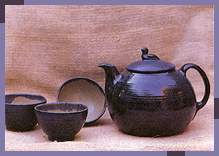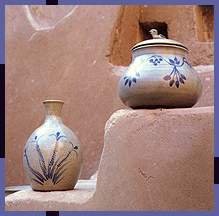|
STONEWARE AND CERAMICS
 Cobalt
Blue Teapot & Bowls - 1991
Cobalt
Blue Teapot & Bowls - 1991 |
Prior to its introduction at Harrania, Ramses Wissa Wassef
had already had considerable experience with stoneware ceramics.
As a lifetime hobby and love, he had spent many years experimenting
with the craft. At home he had built a potter's wheel and
a solar kiln to fire the ware.
In fact, he had built 28 prototype kilns before ultimately
devising one that satisfied him. Based on Ramses' original
design, this type of kiln is still used at the center today.
His extensive experiments with clay mixes and glazes also
enabled him to develop a type that could withstand very high
temperatures. Ramses built a small workshop at the center
expressly for ceramics. In the following passage, he describes
his method of teaching using clay as the medium.
"I had made a number of experiments
with ceramics and developed a paraffin kiln which made it
possible to reach high temperatures very economically. I proceeded
in the same way as for weaving; I fixed up potter's wheels,
bought clay, and showed the children what to do. I then left
them to work on their own, modeling figurines and turning
pots."
Through his experience, Ramses knew that pottery-making had
a technical side which involved a far longer apprenticeship
than tapestry-making. In the beginning, Ramses' constant presence
was necessary in order to give frequent assistance with glazing
and firing. After diligent work and four years of practice,
he
|

|
observed that the young potters had acquired great skill
and that they could glaze and fire their own work. These achievements,
however, were to be just the first phase in the potters' development.
Suzanne Wissa Wassef, Ramses older daughter, was to take a
personal interest in pottery. For a long time Suzanne had
watched her father and had acquired a genuine love for the
craft. This lively interest in ceramics would continue well
after her father's death. Here she describes her role with
the potters.
"Since this craft was not an integral
part of the village tradition, the children's forms lacked
a practical aspect. My role was to direct their creative talent
in producing more functional objects, as well as to allow
the malleability of the material at hand to dictate its own
optimum forms."
In this way Suzanne was able to give new direction to these
children who had learned the technique but lacked the necessary
sense of design. An important aspect of her work is the use
of the single-fire technique. Also used by her father, it
creates a more natural end product. Suzanne's main challenge
with pottery was to rediscover her father's knowledge of firing
kilns. The kiln used for the single-fire method is sensitive
to temperature variations. Here, no barometer is used and
temperatures are judged merely by the colour of the flame.
 Vases
& Jar - 1989 -1991
Vases
& Jar - 1989 -1991 |
"This is a very exciting process,"
concludes Suzanne, "because of
the element of surprise involved each time the kiln is opened."
Today, it is she who designs, glazes and fires all of the
stoneware produced at the center.
|
|